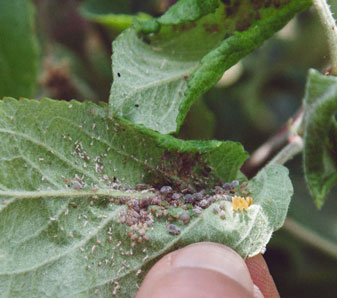Significant Apple Harvest Reduction Due To Rosy Apple Aphid

Table of Contents
Understanding the Rosy Apple Aphid Infestation
The rosy apple aphid (Dysaphis plantaginea), a member of the Hemiptera order, feeds on the plant sap of apple trees, causing widespread damage. Its lifecycle involves multiple generations, with rapid reproduction leading to explosive population growth. Understanding its life cycle is key to effective management. This pest overwinters as eggs on apple tree buds, hatching in spring to begin feeding. These aphids are easily recognizable through several visual indicators.
- Lifecycle and Rapid Reproduction: The rosy apple aphid reproduces asexually through parthenogenesis, enabling rapid population growth under favorable conditions. This allows infestations to quickly escalate from minimal to severe levels within a single growing season.
- Visible Signs of Infestation: Early detection is crucial. Look for these key signs:
- Leaf Curl: Infested leaves often curl upwards, creating a protective environment for the aphids. This leaf curl is a strong indicator of a rosy apple aphid infestation.
- Honeydew Excretion: Aphids excrete a sticky substance called honeydew, which coats leaves and fruit.
- Sooty Mold: Honeydew provides a substrate for the growth of sooty mold, a black fungus that further damages the tree and reduces photosynthetic capacity. This visual identification of sooty mold can signal a more advanced stage of infestation.
- Stages of Infestation and Their Impact:
- Early Infestation: Minimal damage, easily treatable with minimal intervention.
- Moderate Infestation: Noticeable leaf curling and honeydew excretion, leading to reduced fruit set and smaller apples.
- Severe Infestation: Extensive leaf damage, significant fruit loss (potentially up to 80% in severe cases), and overall weakening of the apple tree. This stage requires urgent and intensive intervention.
Impact on Apple Production and Economic Losses
Rosy apple aphid infestations lead to substantial yield reduction, impacting apple farmers' income and the overall agricultural economy. The economic impact extends beyond the farm, affecting market prices and potentially food security.
- Yield Reduction: Studies have shown that severe rosy apple aphid infestations can cause a drastic reduction in apple yields, sometimes reaching 50% or more. These yield reductions translate directly into significant financial losses for growers.
- Economic Implications: The consequences for the apple industry are far-reaching:
- Decreased Fruit Production and Quality: Reduced yields lead directly to lower profits for farmers. The quality of the remaining fruit is also compromised due to damage from the aphids and sooty mold.
- Increased Pesticide Costs and Labor Expenses: Managing infestations often requires significant investment in pesticides and labor for application and monitoring.
- Market Instability Due to Supply Shortages: Reduced apple production can destabilize markets, resulting in price increases for consumers and potential food security concerns, particularly in regions heavily reliant on apple production. This highlights the systemic implications of the rosy apple aphid on our food supply.
Effective Management and Control Strategies for Rosy Apple Aphid
Effective management of rosy apple aphid infestations requires a multi-pronged approach using integrated pest management (IPM) strategies. This involves combining various methods to minimize pesticide use while maximizing control.
- Pest Control Methods:
- Biological Control: Introducing natural predators like ladybugs and lacewings can help control aphid populations without harmful chemicals. This environmentally friendly option works best for early detection and management of infestations.
- Chemical Control: Insecticides can be effective, but careful selection and application are essential to minimize environmental impact and avoid harming beneficial insects. Always adhere to label instructions and consider the impact on pollinators. Specific types of insecticides suitable for rosy apple aphid control should be determined on a case-by-case basis in consultation with agricultural experts.
- Cultural Control: Practices like proper pruning to improve air circulation and sanitation to remove infested plant debris can help reduce aphid populations. Good orchard hygiene is a critical aspect of preventive management.
- Monitoring Techniques: Regular orchard inspection and the use of pheromone traps can provide early warning of infestations, allowing for timely intervention. Early detection can significantly reduce the severity of an infestation.
Preventing Future Infestations
Proactive measures are essential to prevent future rosy apple aphid infestations.
- Prevention and Proactive Management: Regular monitoring and prompt action are crucial. Early detection allows for swift and targeted intervention, minimizing the damage. This proactive approach is often more cost-effective than managing a severe infestation.
- Importance of Early Detection: Detecting infestations early significantly reduces the need for extensive and potentially harmful interventions.
Protecting Apple Harvests from the Rosy Apple Aphid
The rosy apple aphid poses a significant threat to apple production, resulting in substantial economic losses and potential food shortages. Implementing effective management strategies, combining preventative measures with timely intervention, is crucial to protect apple harvests. We must work together to combat this pest and ensure the long-term health and sustainability of apple production. Learn more about managing rosy apple aphid infestations today! Further research into sustainable and environmentally friendly control methods is vital for the future of apple farming. Protect your apple crops – learn more about managing rosy apple aphid infestations today!

Featured Posts
-
 Ufc 313 A Rookie Report Newcomers To Look Out For
May 19, 2025
Ufc 313 A Rookie Report Newcomers To Look Out For
May 19, 2025 -
 Art Review Modern Life A Global Artworld 1850 1950 2025 Perspective
May 19, 2025
Art Review Modern Life A Global Artworld 1850 1950 2025 Perspective
May 19, 2025 -
 Credit Mutuel Am Evaluation Des Resultats Du 4eme Trimestre 2024
May 19, 2025
Credit Mutuel Am Evaluation Des Resultats Du 4eme Trimestre 2024
May 19, 2025 -
 Meer Luchtreizigers Begin 2025 Aanzienlijk Minder Via Maastricht
May 19, 2025
Meer Luchtreizigers Begin 2025 Aanzienlijk Minder Via Maastricht
May 19, 2025 -
 Vermont Agency Of Education 2025 Presidential Scholars Revealed
May 19, 2025
Vermont Agency Of Education 2025 Presidential Scholars Revealed
May 19, 2025
Latest Posts
-
 Gazze De Yerinden Edilmenin Filistinliler Uezerindeki Etkisi
May 19, 2025
Gazze De Yerinden Edilmenin Filistinliler Uezerindeki Etkisi
May 19, 2025 -
 Filistinli Muelteciler Gazze Deki Varolus Muecadelesi
May 19, 2025
Filistinli Muelteciler Gazze Deki Varolus Muecadelesi
May 19, 2025 -
 Resultats Q4 2024 Credit Mutuel Am Impact Et Perspectives
May 19, 2025
Resultats Q4 2024 Credit Mutuel Am Impact Et Perspectives
May 19, 2025 -
 Gazze Deki Filistin Mueltecilerinin Yasam Kosullari Ve Zorluklari
May 19, 2025
Gazze Deki Filistin Mueltecilerinin Yasam Kosullari Ve Zorluklari
May 19, 2025 -
 Gazze Skandali Trump Dansoezler Altin Ve Elon Musk In Baglantisi
May 19, 2025
Gazze Skandali Trump Dansoezler Altin Ve Elon Musk In Baglantisi
May 19, 2025
